Sourdough Cinnamon Raisin English Muffins
This post may contain affiliate links.
These sourdough cinnamon raisin English muffins are such a lovely way to use your sourdough starter. They're the perfect balance of tangy and sweet, and taste delicious toasted with a little (or a lot of) butter.
These spiced English muffins are quite simple to make. After mixing, you'll leave the dough to ferment overnight, but if you need to cook the muffins later, you can cold ferment them in the fridge for 3 days.
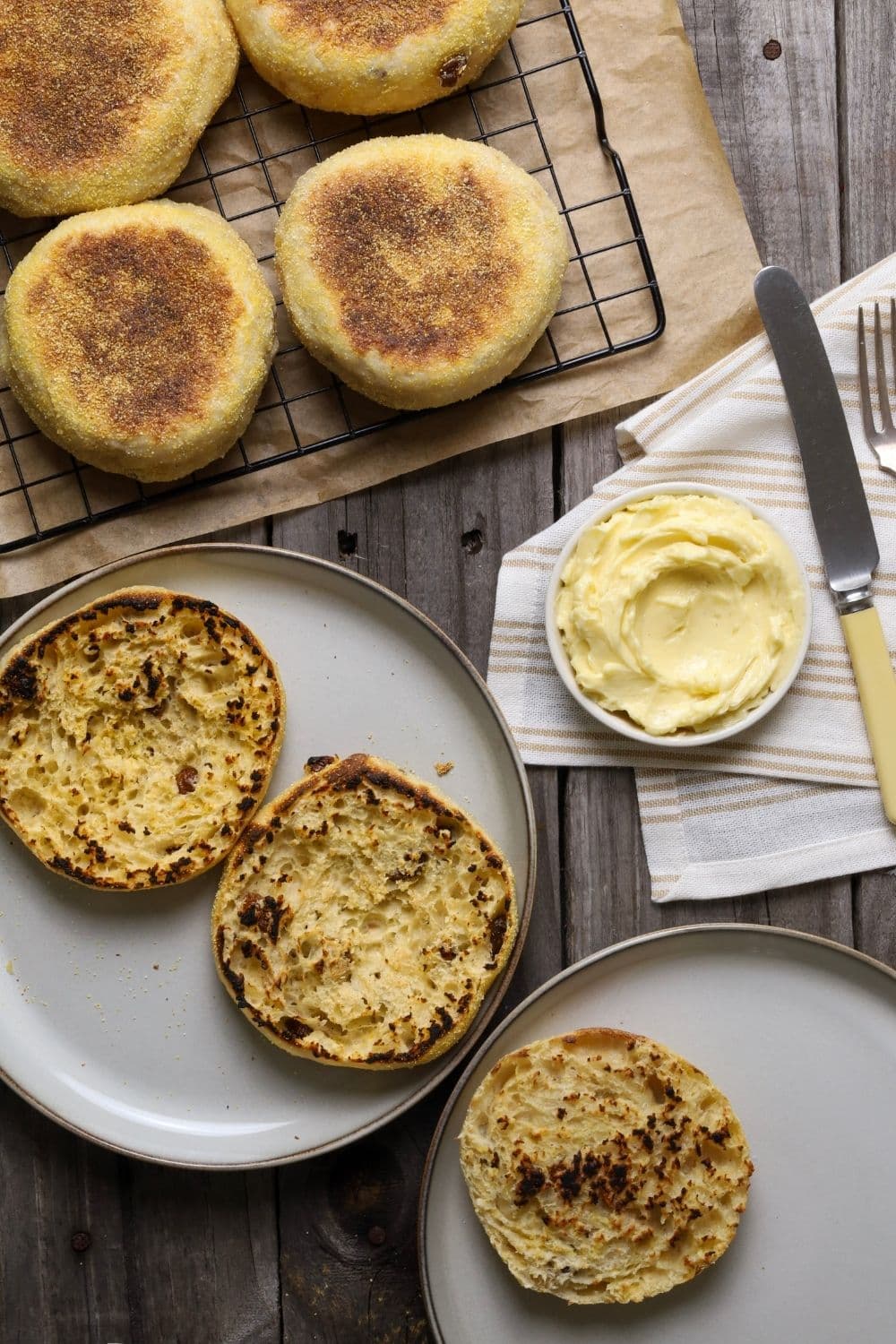
These slightly sweet English muffins are wonderful toasted with butter (especially homemade butter) or a whipped honey cinnamon butter, but if you're feeling adventurous, will be delicious with a spiced pumpkin cream cheese or a fig cream cheese.
And if you'd rather have English muffins without the skillet, I've created this sourdough English muffin loaf recipe that tastes just like your favorite rounds, but is baked in a loaf pan.
Why You'll Love This Recipe!
Perfect Tangy Sweet Flavor - with just a bit of honey, and the addition of raisins, these tangy English muffins get a subtle sweetness that's just delicious.
Soft and Crisp- homemade English muffins gives you the contrast you want—crisp, golden outsides from a skillet cook, and soft, chewy insides full of those nooks and crannies. So much better than store-bought.
Freezer Friendly - these English muffins freeze well, making them great for make ahead breakfasts or a quick sweet sandwich bread.
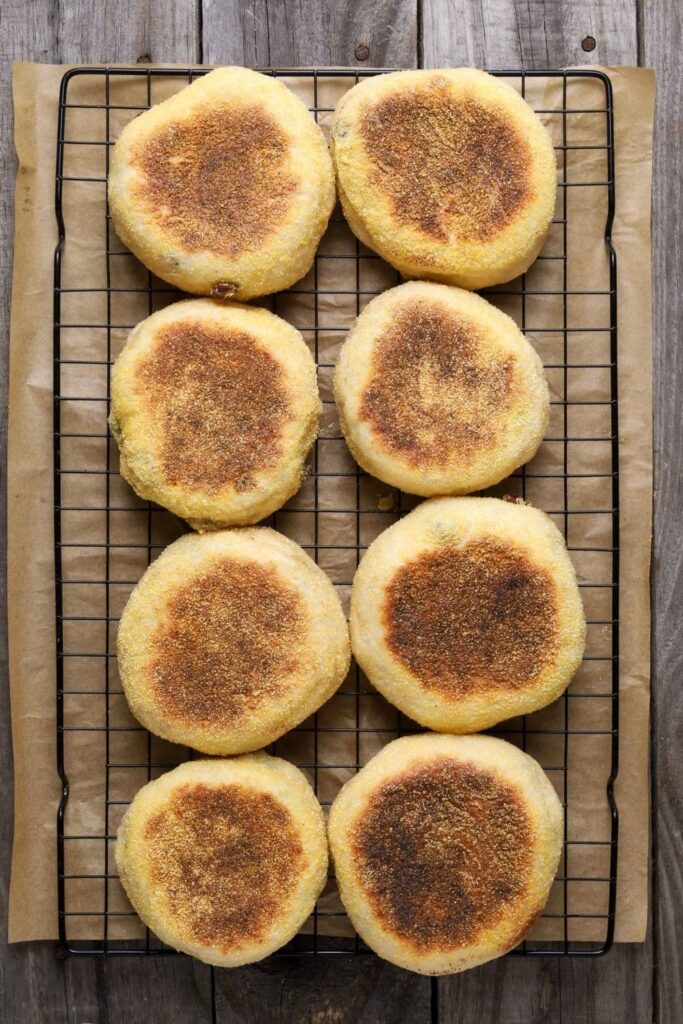
Ingredients
- Sourdough Starter - use fed and bubbly starter. You want to have that tangy flavor that makes English muffins so special.
- Milk - use cold milk. We'll ferment the dough overnight, which is totally okay even though the dough has milk.
- Bread Flour - I've tested this recipe with bread flour for best results.
- Salt
- Honey - I love the sweetness honey adds, but you can use sugar if you want to.
- Cinnamon - cinnamon is known to hamper fermentation, especially in wild yeast starters. This is still the case here, but you'll just need to be prepared for a long fermentation. If your starter is fairly young, I do recommend adding just a little bit of yeast to overcome the cinnamon. If your starter is well established you should not have an issue as long as you don't go over the 1 teaspoon of cinnamon.
- Raisins - go for unsweetened raisins, and make sure they're fresh for best texture.
- Cornmeal - you'll use cornmeal for dusting. You can use plain flour to dust them if you need to, but the texture won't be the same. Semolina is a good substitute if you need one.
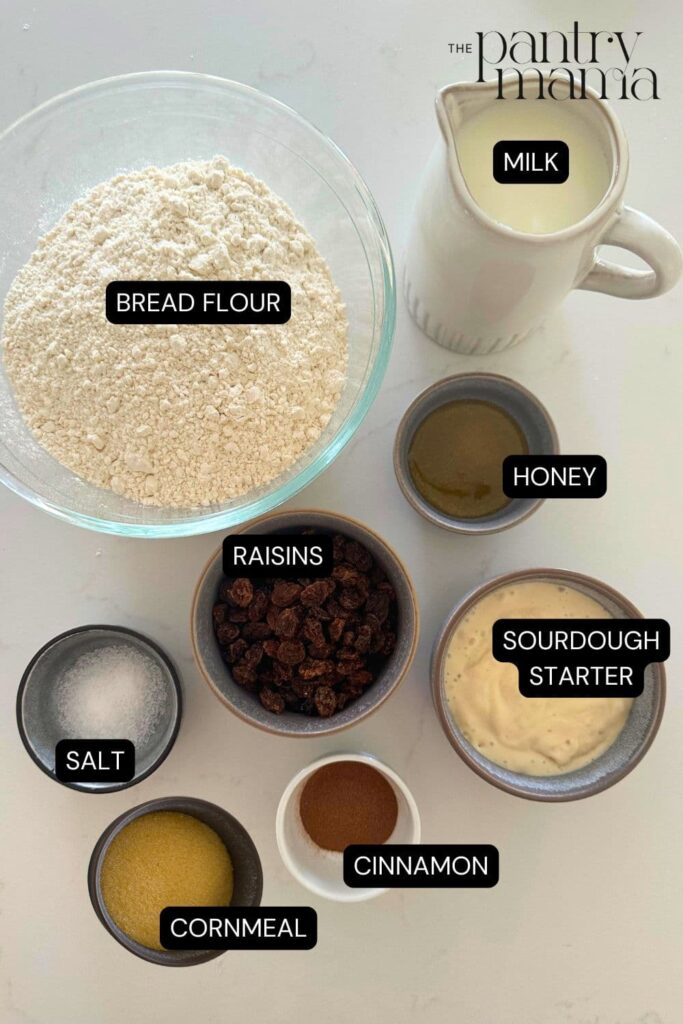
How to Make Sourdough Cinnamon Raisin English Muffins
I've had many readers ask me for a cinnamon raisin English muffin recipe, so I created this one from my regular sourdough English muffins.
In a large glass bowl, mix together all of the ingredients, including your sourdough starter and bring it together to form a dough. The dough will be quite sticky. Gently knead the dough to bring it together. It's easy to do by hand in the bowl for less washing up, but if you prefer to do it in a stand mixer that's perfectly fine too.
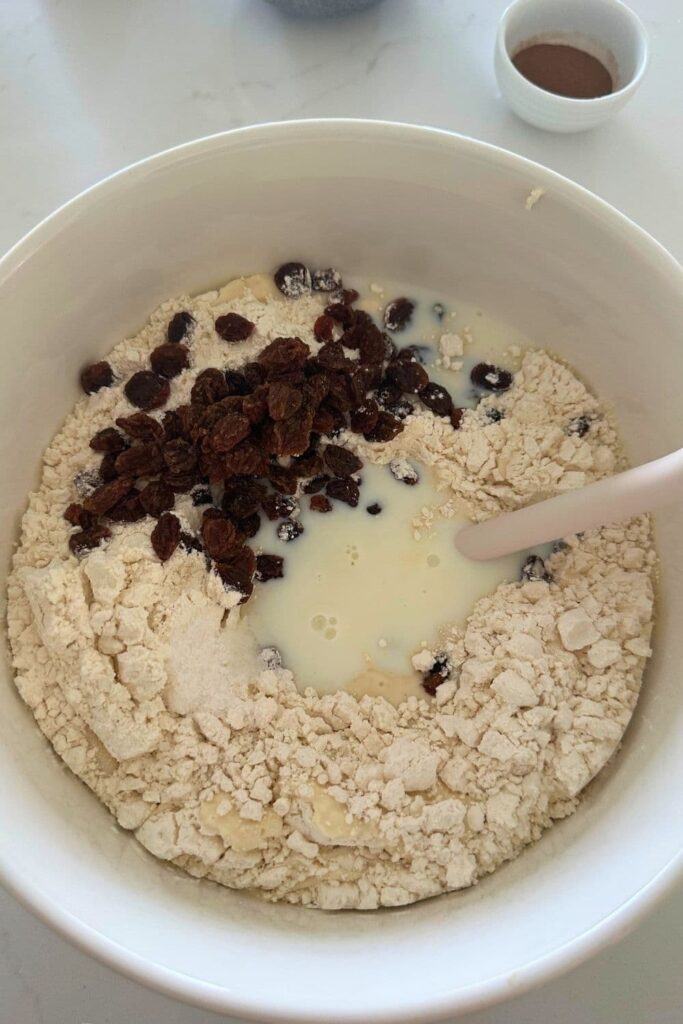
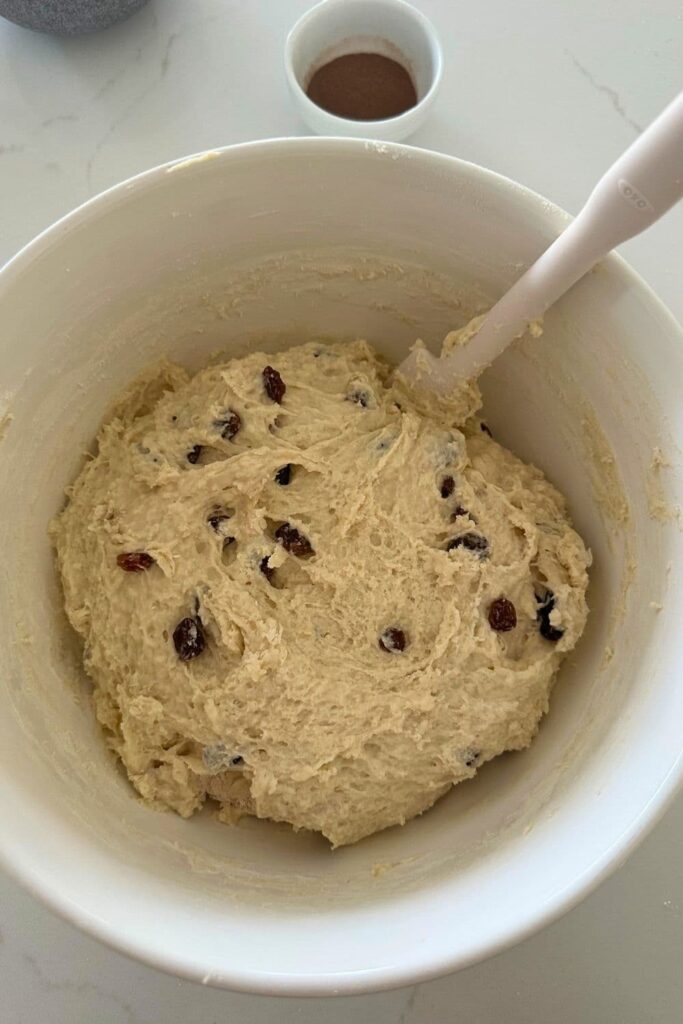
Once you have a dough formed, cover it in plastic wrap and set aside for around 12 hours to ferment at room temperature (see notes). You want the dough to rise (it doesn't need to double though). It should rise at least half in the bowl and become a smoother, structured dough (see the pics above of my dough).
It's important that the dough maintains its gluten structure in order to be shaped into rounds. Just like traditional sourdough bread, you'll need to watch the dough, rather than the clock.
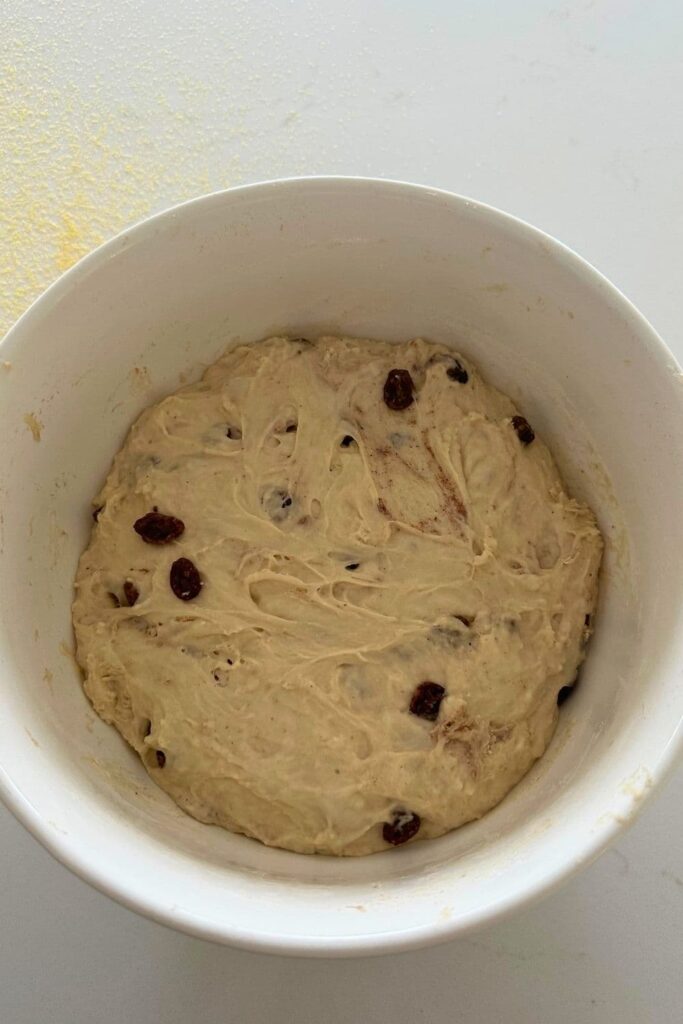
Once you're happy with the dough, you can wet your hands and gently shape your dough into a rough ball by performing a set of stretch and folds. This will deflate the dough - but don't worry.
Now leave the dough to rest for around 30 minutes.
Dust your work surface with corn meal and then ease the dough out of the bowl. Sprinkle corn meal on the top of the dough too. Depending on how sticky your dough is, you might need to add some extra as you go along so keep it handy.
Gently press the dough into a rectangle using your hands. Using a rolling pin, gently roll your dough to around ½ - ¾ inch thick.
You don't want it too thick or your muffins will be doughy and take too long to cook in the middle. Using a biscuit cutter (or glass or plastic tumbler) gently cut out rounds of your dough and place them on a baking sheet lined with parchment paper and dusted with corn meal. Keep going until you can't cut any more.
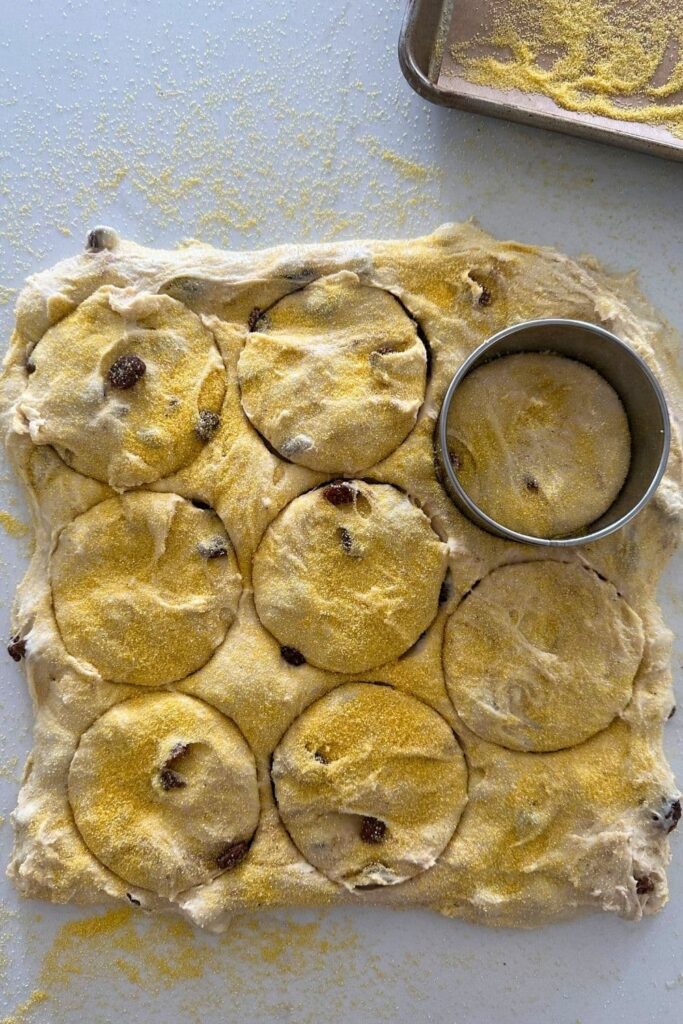
Then gather up the dough, roll it back out and repeat until you've used all the dough up.

Cover the muffins with a tea towel and leave to rest for around 30 minutes.

Heat a fry pan or skillet on the stove top. You want a medium heat - you don't want to burn the outside and leave the inside raw, so just keep an eye on them and adjust as you need to. Place 4 - 6 muffins in your skillet, cover with the lid and cook for around 6 minutes on each side.
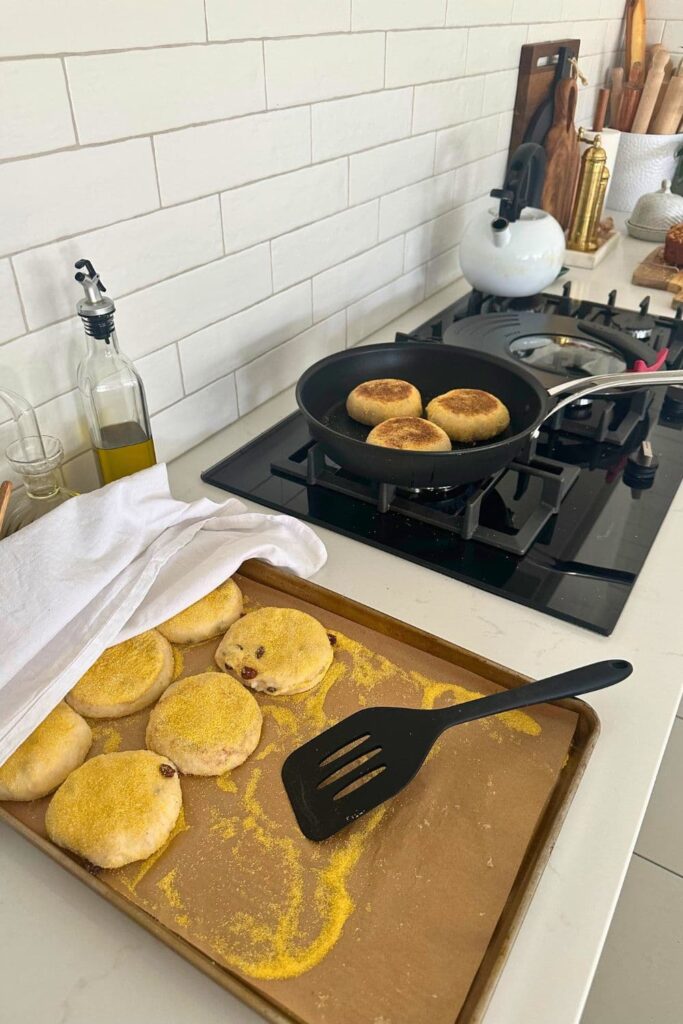
There is no need for oil or butter, the corn meal will protect them from sticking. Turn them over once you see the dough bubbling (they will be puffed up from the heat).Once they are golden on each side, take off the heat and allow to cool. Repeat the process until all of the muffins are cooked.
Once they are cool, use a fork to split them and enjoy them with butter or toast them for extra golden goodness!

Kate's Recipe Tips
Switch the Flour - you can use plain or all purpose flour instead of Bread flour or Baker's flour if you want to. But you may find that you need to reduce the amount of milk.
House Temperature - sourdough English Muffins are meant to be fermented for a longer period (it's what gives them the most amazing flavor), however if the ambient temperature in your home is over 28C you may need to use your refrigerator. Once you've mixed the dough, allow it to ferment a little while on the kitchen counter - no more than an hour. Then place the dough into the fridge to ferment. It will take up to 3 days to fully ferment in the fridge.
Sourdough Discard - if you want to use your discard in this recipe, just use it instead of active starter and add a half teaspoon of commercial yeast to your mixture. Make sure your discard isn't too old, up to a week is ok.
Fork Split - Don't use a knife to cut your English muffins! Split them with a fork for the best nooks and crannies to hold all the butter and jam. Make sure they are cooled through before splitting.
How to Store + Freeze
Store in an airtight container or Ziploc bag at room temperature for 1-2 days.
Cooked sourdough English muffins freeze beautifully. Store them in Ziploc bags, and when you're ready, just defrost and toast. For easy toasting later, be sure to fork-split them before freezing. They'll stay fresh in the freezer up to 3 months.
Frequently Asked Questions
It is true that cinnamon can hamper fermentation, however, as long as you stick to just 1 teaspoon you should be fine. If your starter is still young, adding a little bit of commercial yeast is a good idea. If you're really worried about the cinnamon, you can leave it out and allow the dough to ferment for a few hours before adding it, just to give the starter time to activate. I have made these many times though and while they do take quite a while to ferment, the dough will rise, even with cinnamon.
I don't really recommend substituting cornmeal because that is what gives English muffins their unique texture. Depending on where you live, you might need to look for either cornmeal or polenta. Don't get this mixed up with cornflour (this is cornstarch and something very different to cornmeal).
You can bake them in the oven if you want to, however they won't always get the nice golden brown sides. I recommend laying them out on a large baking tray and placing them into a 175C (350F) oven and baking for around 15 minutes, or until you're happy with their color. If you are baking a lot of them, you can also start them in the skillet to get the initial color on each side and then finish them in the oven (perfect for large breakfast gatherings or lunches).


Sourdough Cinnamon Raisin English Muffins
Equipment
- Mixing Bowl
- Cast Iron Skillet
- Biscuit Cutter (I've used a 3" round)
Ingredients
- 200 g Sourdough Starter (fed and bubbly - reduce in warmer weather)
- 500 g Milk (cold is better for overnight ferment)
- 600 g Bread Flour
- 12 g Salt
- 20 g Honey (you can use sugar if you want to)
- 1 teaspoon Cinnamon
- 120 g Raisins
- 50 g Cornmeal (for dusting)
Instructions
- In a large glass bowl, mix together all of the ingredients, including your sourdough starter and bring it together to form a dough. The dough will be quite sticky. Gently knead the dough to bring it together.It's easy to do by hand in the bowl for less washing up, but if you prefer to do it in a stand mixer that's perfectly fine too.
- Once you have a dough formed, cover it in plastic wrap and set aside for around 12 hours to ferment at room temperature (see notes). You want the dough to rise (it doesn't need to double though). It should rise at least half in the bowl and become a smoother, structured dough (see the pics above of my dough). It's important that the dough maintains its gluten structure in order to be shaped into rounds.Just like traditional sourdough bread, you'll need to watch the dough, rather than the clock.
- Once you're happy with the dough, you can wet your hands and gently shape your dough into a rough ball by performing a set of stretch and folds. This will deflate the dough - but don't worry. Now leave the dough to rest for around 30 minutes.
- Dust your work surface with corn meal and then ease the dough out of the bowl. Sprinkle corn meal on the top of the dough too. Depending on how sticky your dough is, you might need to add some extra as you go along so keep it handy.
- Gently press the dough into a rectangle using your hands. Using a rolling pin, gently roll your dough to around ½ - ¾ inch thick. You don't want it too thick or your muffins will be doughy and take too long to cook in the middle. Using a biscuit cutter (or glass or plastic tumbler) gently cut out rounds of your dough and place them on a baking sheet lined with parchment paper and dusted with corn meal. Keep going until you can't cut any more. Then gather up the dough, roll it back out and repeat until you've used all the dough up.Cover the muffins with a tea towel and leave to rest for around 30 minutes.
- Heat a fry pan or skillet on the stove top. You want a medium heat - you don't want to burn the outside and leave the inside raw, so just keep an eye on them and adjust as you need to. Place 4 - 6 muffins in your skillet, cover with the lid and cook for around 6 minutes on each side. There is no need for oil or butter, the corn meal will protect them from sticking. Turn them over once you see the dough bubbling (they will be puffed up from the heat).Once they are golden on each side, take off the heat and allow to cool. Repeat the process until all of the muffins are cooked.
- Once they are cool, use a fork to split them and enjoy them with butter or toast them for extra golden goodness!
Notes
Nutrition



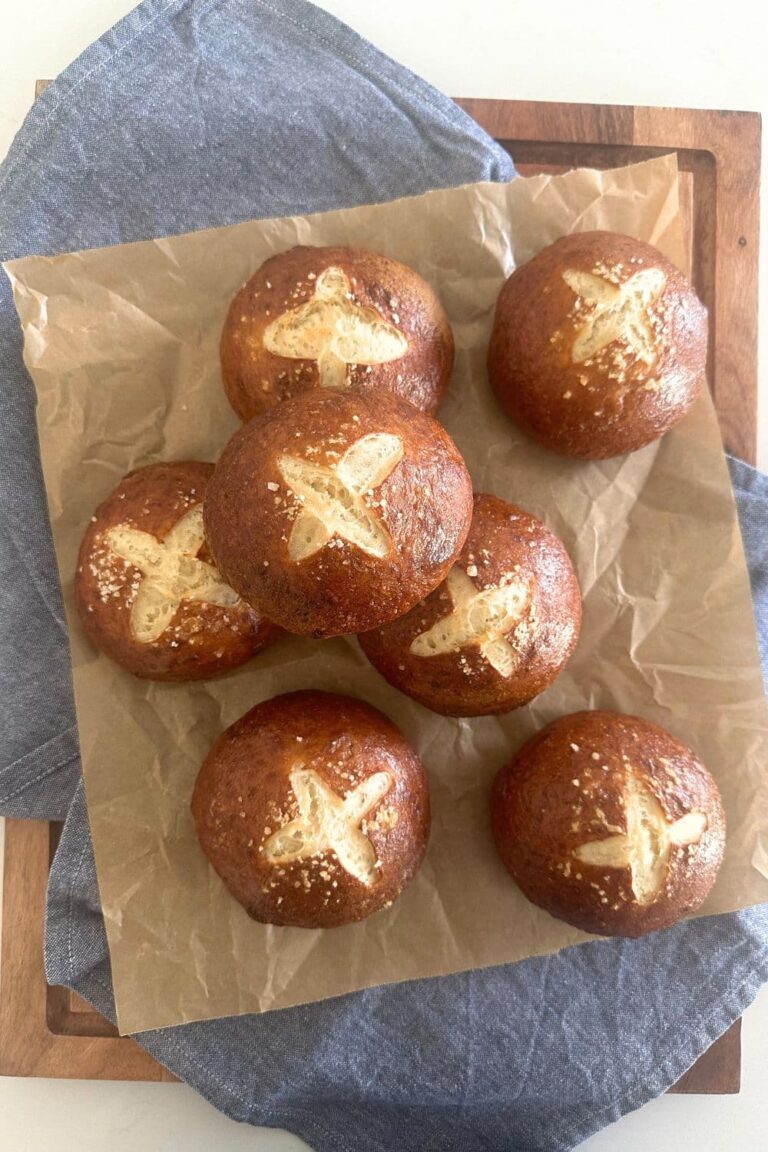
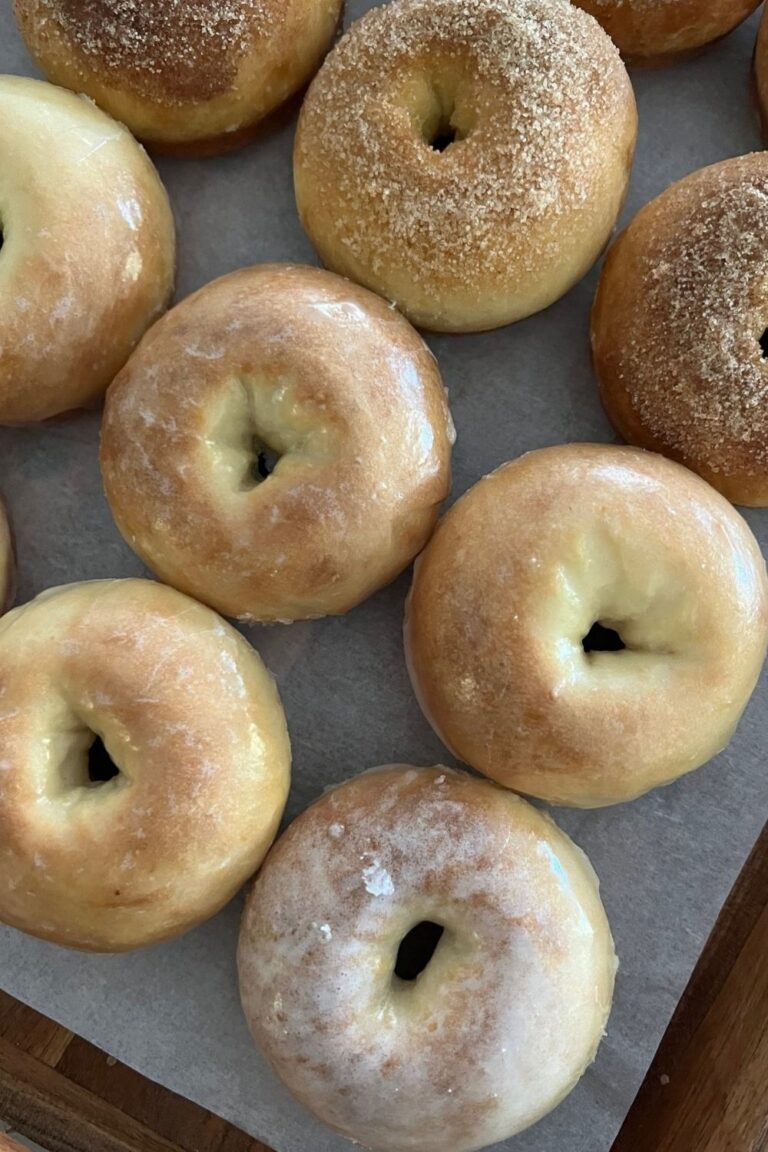
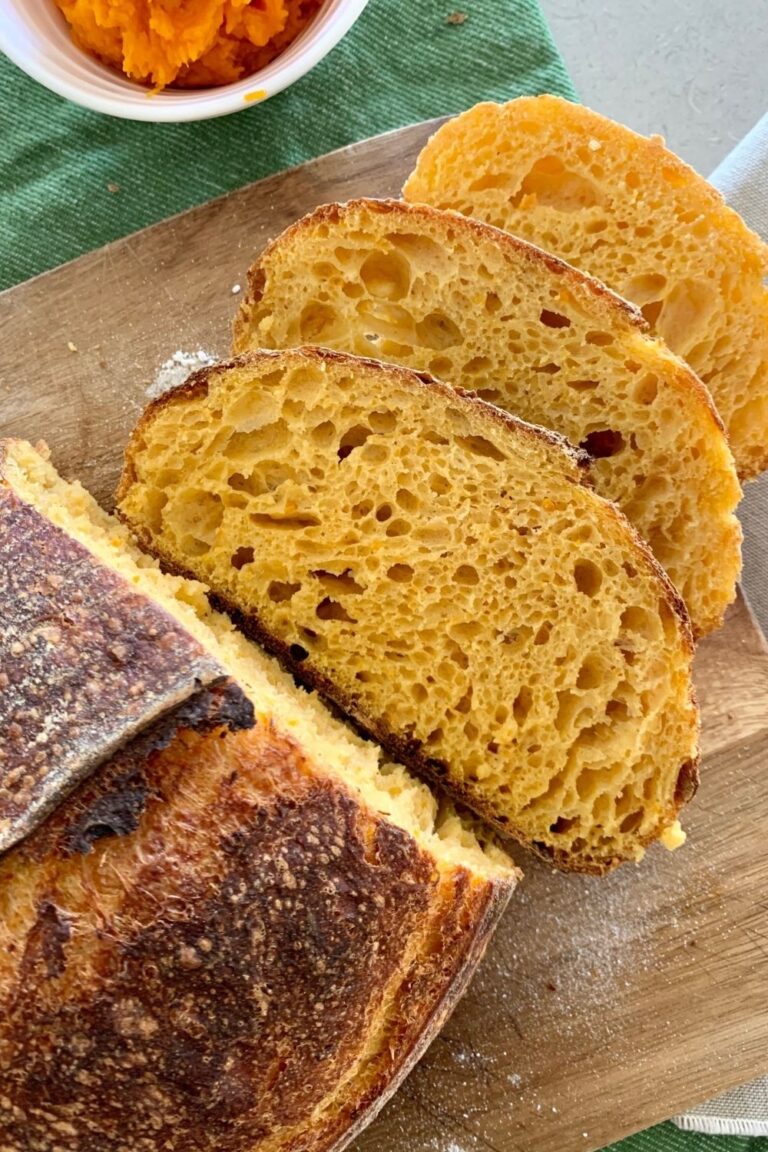


Could I used butter milk for this recipe?
You could use buttermilk for these sourdough cinnamon raisin English muffins, yes 🙂